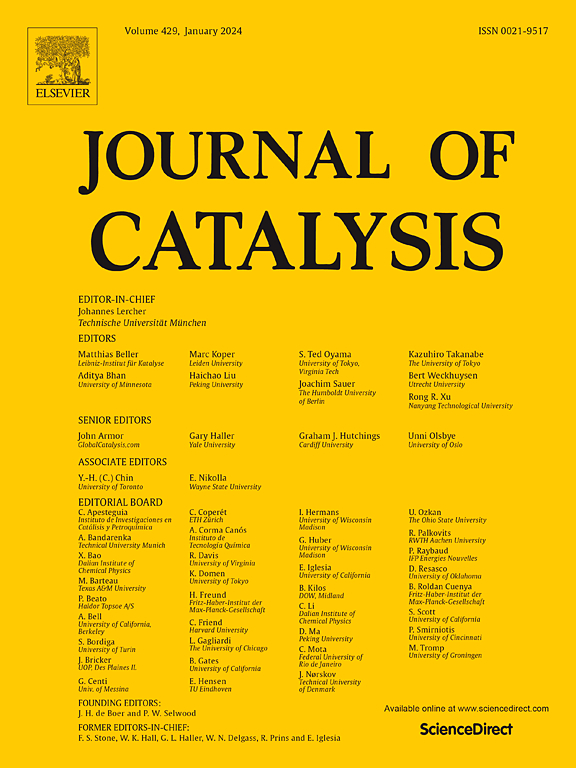Enantioselective synthesis of δ-Boryl chiral amines/amides via copper-catalyzed sequential hydroboration hydroamination/hydroaminocarbonylation of methylenecyclopropanes
IF 6.5
1区 化学
Q2 CHEMISTRY, PHYSICAL
引用次数: 0
Abstract
We report the development of a copper-catalyzed asymmetric synthesis of δ-boryl chiral amines and amides via sequential ring-opening reactions of methylenecyclopropanes (MCPs). Using Cu(OAc)2 /(R)-DTBM-Segphos catalytic system, MCPs undergo hydroboration-hydroamination with HBpin and hydroxylamine esters to produce δ-boryl chiral amines in good yields (up to 85 %) and excellent enantioselectivities (up to >99 % ee). The method shows broad substrate scope, tolerating various functional groups and structural motifs. Additionally, CuCl/(S,S)-Ph-BPE enables sequential hydroboration-hydroaminocarbonylation of MCPs under CO atmosphere, affording δ-boryl chiral amides with high enantioselectivity (up to 99 % ee). The synthetic utility of these methods is highlighted through various stereospecific transformations of the products. Mechanistic studies indicate that these transformations proceed via copper-catalyzed ring-opening hydroboration to form homoallylic boronate intermediates, followed by enantioselective hydroamination or hydroaminocarbonylation steps to produce the final δ-boryl chiral amines and amides.

铜催化甲环丙烷序贯硼酸氢化/氨基化对映选择性合成δ-硼基手性胺/酰胺
本文报道了一种铜催化甲基环丙烷序开环反应合成δ-硼基手性胺和酰胺的方法。使用Cu(OAc)2 /(R)-DTBM-Segphos催化体系,MCPs与HBpin和羟胺酯进行硼氢化-氢胺化反应,以良好的收率(高达85 %)和优异的对映选择性(高达99 % ee)生产δ-硼基手性胺。该方法具有广泛的衬底适用范围,可容纳各种官能团和结构基元。此外,CuCl/(S,S)-Ph-BPE能够在CO气氛下实现MCPs的顺序硼氢化-氢氨基羰基化,提供具有高对端选择性(高达99% % ee)的δ-硼基手性酰胺。通过对产物进行各种立体定向变换,突出了这些方法的合成效用。机理研究表明,这些转化通过铜催化的开环硼氢化反应形成同丙烯基硼酸盐中间体,然后进行对映选择性氢胺化或氢胺羰基化步骤,最终产生δ-硼基手性胺和酰胺。
本文章由计算机程序翻译,如有差异,请以英文原文为准。
求助全文
约1分钟内获得全文
求助全文
来源期刊

Journal of Catalysis
工程技术-工程:化工
CiteScore
12.30
自引率
5.50%
发文量
447
审稿时长
31 days
期刊介绍:
The Journal of Catalysis publishes scholarly articles on both heterogeneous and homogeneous catalysis, covering a wide range of chemical transformations. These include various types of catalysis, such as those mediated by photons, plasmons, and electrons. The focus of the studies is to understand the relationship between catalytic function and the underlying chemical properties of surfaces and metal complexes.
The articles in the journal offer innovative concepts and explore the synthesis and kinetics of inorganic solids and homogeneous complexes. Furthermore, they discuss spectroscopic techniques for characterizing catalysts, investigate the interaction of probes and reacting species with catalysts, and employ theoretical methods.
The research presented in the journal should have direct relevance to the field of catalytic processes, addressing either fundamental aspects or applications of catalysis.
 求助内容:
求助内容: 应助结果提醒方式:
应助结果提醒方式:


